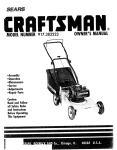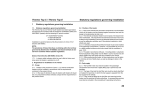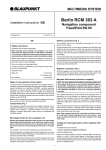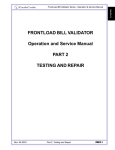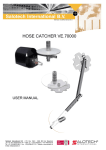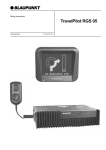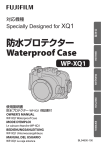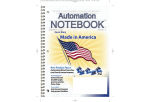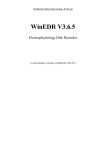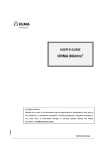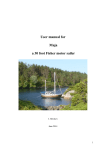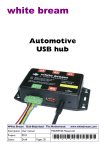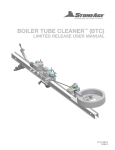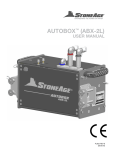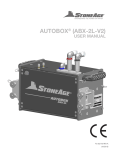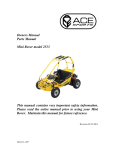Download HOSE CATCHER VE.90000
Transcript
HOSE CATCHER VE.90000-CST USER MANUAL Manufacturer Version of document Date of document VE.90000-CST Salotech International B.V. Jan van der Heijdenstraat 44 3261 LE Oud-Beijerland Tel: + 31 (0)186 621484 Fax: +31 (0)186 621113 Website: www.waterjetting.nl 1 05-2010 Rev 1. 05-2010 Page 1 of 27 Contents 1. FOREWORD .................................................................................................................................... 4 1.1 USING THE MANUAL ..................................................................................................................... 4 1.2 GUARANTEE ................................................................................................................................ 4 1.3 SAFETY REGULATIONS ................................................................................................................. 5 1.4 INTENDED USE FOR THE VE.90000-CST ...................................................................................... 7 1.5 NORMS AND REGULATIONS........................................................................................................... 7 1.6 TIP MARKINGS ............................................................................................................................. 8 1.7 SAFETY PICTOGRAMS .................................................................................................................. 9 1.7.1 Pictograms on the equipment ............................................................................................ 9 1.8 PERSONAL PROTECTION EQUIPMENT .......................................................................................... 10 1.9 ALGORITHM............................................................................................................................... 11 2. ASSEMLY DRAWING VE.90000-CST .......................................................................................... 13 2.1 2.2 2.3 2.4 2.5 2.6 3. PARTS LIST OF FIGURE 1 ............................................................................................................ 14 ASSEMBLY DRAWING CARRIAGE ................................................................................................. 15 ASSEMBLY DRAWING CLAMP....................................................................................................... 16 PARTS LIST OF FIGURE 2 AND 3 .................................................................................................. 17 ASSEMBLY DRAWING SPLASHGUARD WITH HOLDER...................................................................... 18 PARTS LIST FOR HOLDER WITH SPLASHGUARD............................................................................. 18 ASSEMBLY AND USE .................................................................................................................. 19 3.1 3.2 ASSEMBLY DIRECTION ............................................................................................................... 20 SELECTION TABLE STOPPER ....................................................................................................... 22 4. OPERATION .................................................................................................................................. 23 5. MAINTENANCE ............................................................................................................................. 24 5.1 GENERAL .................................................................................................................................. 24 5.1.1 Preventative daily maintenance ....................................................................................... 25 5.2 PREVENTATIVE ANNUAL MAINTENANCE ....................................................................................... 25 5.3 SPARE PARTS............................................................................................................................ 25 6. MALFUNCTIONS AND REPAIRS ................................................................................................. 26 6.1 7. VE.90000-CST MALFUNCTIONS VE.90000-CST ................................................................................................ 26 DISASSEMBLY AND REMOVAL ................................................................................................. 26 Rev 1. 05-2010 Page 2 of 27 This authorized English manual is a translation of the original Dutch manual. It is the property of Salotech International B.V. No rights can be derived from this translation. © Copyright 2010 Although Salotech International B.V. has taken great care in providing an accurate and – wherever necessary – comprehensive description of particular components, it renounces all liability for damage as a result of inaccuracies and/or insufficiencies found in this manual. Salotech International B.V. retains the right to change, at any point in time, machine components or the contents of this manual, without prior notice to the owner of the machine. No part of this publication may be reproduced and/or made public via printing, photocopy, microfilm, audio tape, electronic form or any other form, without prior written consent from Salotech International B.V. Breaches are punishable by law and necessitate compensation. VE.90000-CST Rev 1. 05-2010 Page 3 of 27 1. FOREWORD We thank you for purchasing the VE.90000-CST. Working with high pressure equipment is accompanied by certain risks. Thus it is in your best interest to first read the safety instructions in this user manual and to then carefully implement them. This manual contains descriptions about use, maintenance and repair of this equipment. Further, there are also descriptions about the machine’s main components. The information in this manual is important for safe and effective operation of this equipment. If you are not familiar with the operation, the preventive maintenance etc. of the VE.90000-CST, then please carefully read this user manual from start to finish. Keep this user manual to-hand for future reference. The required information can be quickly found using the table of contents. In this user manual, the words ‘machine’ and ‘equipment’ are used inter-changeably. Both words refer to the VE.90000-CST. This is also the case with the words ‘user manual’, ‘document’ and ‘manual’; all words refer to this document and accompanying appendices. 1.1 Using the manual This manual has been written for authorized and technically-qualified persons. Tasks have only been assigned to specific persons (technically qualified or not) in the chapters ‘maintenance' and ‘configuration’. All concerned parties must familiarize themselves with the contents of this user manual. These persons are distinguished as follows: Authorized persons are people who: Have built up a certain level of knowledge via schooling or training and who have enough experience to operate the machine. Technically qualified persons are people who: Are technically qualified and have sufficient technical knowledge via schooling and/or on-the-job experience. Further, these persons are, due to their knowledge of mechanics, well aware of possible risks and dangers (a mechanic, for example). The word ‘operate’ means: Configuring the VE.90000-CST, working with the equipment and performing simple maintenance activities. The aim/purpose of this user manual is to create safe and efficient interaction between people and the machine. 1.2 Guarantee The guarantee conditions and the conditions concerning liability can be found in the supply conditions (Metal Union, submitted to the Registry at the District Court in Rotterdam). VE.90000-CST Rev 1. 05-2010 Page 4 of 27 1.3 Safety regulations Safety is the first priority! Everyone is responsible for a clean, safe and well-lit workplace. Immediately report danger and/or dangerous situations to your supervisor. Salotech International B.V. advises you to train operators and maintenance personnel to operate, maintain and troubleshoot for this equipment. Operators must be at least 18 years old. Only personnel authorized by the equipment manager may operate this machine or perform activities in the proximity of the machine. It is strictly recommended that operators are familiar with the directives laid down by the Stichting Industriële Reiniging (SIR) [Industrial Cleaning Foundation], and that they also possess a certificate for ‘High Pressure Operator’ and/or have sufficient experience with high pressure equipment. It is paramount that the user is well aware, via training and/or experience (legally recognized), of high pressure technology, high pressure cleaning and all accompanying safety measures – which must be implemented in full. Never use high pressure equipment with a maximum working pressure that is lower than the maximum working pressure of the high pressure unit. Use clean water (fresh or salt) with a maximum temperature of 40°C (110°F), in order to prevent cavitation. Never point the jet at people or animals. A high pressure liquid jet enters deep into the skin and can lead to serious wounds, permanent injury and even death. Anyone who is struck by a high pressure water jet must always seek immediate professional medical care. All personnel assigned the task of operating the machine must be able to demonstrate that they have read and understood those parts of the user manual that describe the machine’s operation and safety considerations. All personnel assigned the task of assembling, putting into operation, maintaining and/or repairing the machine must be able to demonstrate that they have read and understood the entire manual. The user(s) of the machine is (are), under all circumstances, responsible for the interpretation and use of the manual. In cases of doubt, contact the supplier/manufacturer. The manual must be kept in close proximity to the machine and must be easily accessible to operators and maintenance personnel. If prescribed configurations are altered or use is made of unauthorized spare parts or repair methods, this absolves the manufacturer of any liability. The surroundings of the machine must comply with Arbo regulations. The user is responsible for taking steps to ensure that the machine can be operated safely and that the environment is sufficiently illuminated. It is forbidden to use the machine in an environment where there is a risk of explosion. VE.90000-CST Rev 1. 05-2010 Page 5 of 27 The machine’s safety features are in keeping with the latest technology and are in accordance with the relevant European guidelines. The equipment may not be modified without prior written consent from the manufacturer. The owner of the machine is responsible for adhering to the instructions stated in this manual. Safety features (e.g. screens) may never be removed or in any way disengaged. VE.90000-CST Rev 1. 05-2010 Page 6 of 27 1.4 Intended use for the VE.90000-CST The VE.90000-CST is a specially constructed adjustable auxiliary tool for cleaning pipe bundles by means of a jet hose with a cleaning nozzle, sometimes with an extension. All the pipes in the bundle can be reached because of the X-Y construction. Jet hoses of different diameters can be used because the interchangeable stoppers also have different diameters. A round transparent (Lexaan) splashguard has been fixed on to protect the operator from splashback. The VE.90000-CST is not intended to be mounted on vertical heat exchangers. A maximum reaction force of 500N can be absorbed by the VE.90000-CST hose catcher. Any other use of the equipment, without prior written consent from the manufacturer, absolves the manufacturer of any responsibility or liability. 1.5 Norms and regulations The CE mark on the machine’s type plate indicates that this equipment has been designed and constructed in accordance with the requirements of the Machine directive (2006/42/EC) and the low voltage directive (73/23/EEG). For an overview of the norms implemented during the design and construction of the machine, please refer to the declaration of incorporation of partly completed machinery (at the back of this user manual). VE.90000-CST Rev 1. 05-2010 Page 7 of 27 1.6 Tip markings Tip markings are symbols in the user documentation and are not displayed on the machine. The following tip markings are used to make you aware of risks and/or dangerous situations: Tip: Suggestions and advice to make tasks easier. Note: Additional information that makes you aware of possible problems. Caution: Deviating from procedures can damage the machine/equipment. Danger: Deviating from procedures can lead to serious injury. Reference: Further information about this subject is available elsewhere in this manual. VE.90000-CST Rev 1. 05-2010 Page 8 of 27 1.7 Safety pictograms Respect these signs; they have been placed for your own safety! The risk analysis for this machine has indicated a number of safety measures for warning the user. The used safety pictograms are repeated in the user manual and on the machine’s work instructions. This clearly provides the user with an insight into the present risks. We have highlighted three different pictogram types: Prohibition sign: Not allowed to perform an action. Obligation sign: Obligatory process or action by the user. Warning sign: Making user aware of present danger. 1.7.1 Pictograms on the equipment Regularly check that all pictograms are still visible and legible. If pictograms are illegible, replace them! Pictogram or text VE.90000-CST Description Position on the equipment Warning: Risk of hand trapping. Only accessible to technically-qualified personnel. On the outer side of protective shield CE mark: Indicates conformity with European guidelines. The CE mark is found on the type plate of the equipment. Rev 1. 05-2010 Number X X Page 9 of 27 1.8 Personal protection equipment All operators and persons in close proximity must wear the following personal protection equipment: Body protection A strong waterproof suit must complete protect against the characterization of the water and debris. Arms and legs must be covered. The pants must worn over the boots Hand protection Waterproof rubber gloves, laminate fabrics or with reinforced steel), which give enough support to the cleaning equipment and have a long sleeve for a good connection on the suit Foot protection Waterproof spraying boots with a steel cap, which protects to high pressure spray. Recommend is boots with a special airspace on the foot. Also the boots need to have enough support on a wet surface. Face protection All personnel must wear suitable head protection (plastic helmet). If possible, personnel must wear a face visor. This must match against the capture of splashing spraying water and pollutions. It must have dimensions and shape, so the complete face is protected and give a clear sight during cleaning activities It is not allowed to work with the face protection up and only wearing safety glasses It is not useful to wear safety glasses under a face protector. Operator who wear glasses under the face protector and need to wear the glasses, this has to be safety glasses special for the operator. Ear protection Use ear plugs or ear muffs to protect the ear (regularly in excess of 80 dB)). Ear protection must be worn according to ARBO, ARAB / codex guidelines. Protection of air passages The air passages must be protected if this can prevent possible injuries. VE.90000-CST Rev 1. 05-2010 Page 10 of 27 1.9 Algorithm Order assignment / order acquisition Level 1 Green zone Level 2 Green zone Level 3– ORANGE Zone Acceptable Fully-automatic remote control possible Semi-automatic operator protection possible Implementation ok Implementation ok Hose catcher + Hose sleeve on cleaning hose ok Implementation Demonstrable consultation between Contractor and Customer Assessment of extra risks Level 4 – RED Zone HIGHLY DISCOURAGED Level 5 – RED Zone HIGHLY DISCOURAGED Level 6 FORBIDDEN ZONE VE.90000-CST Cleaning hose / Extension + Special PPE Cleaning hose with marking ring or lance + Special PPE Implementation ok Implementation ok Cleaning hose without marking ring Rev 1. 05-2010 Page 11 of 27 The high pressure hose must have hose sleeves at 5 to 20 cm from each end. A high pressure hose with a hose sleeve may only be used with the VE.90000-CST hose catcher. A high pressure hose with a marking ring may NOT be used with the VE.90000-CST hose catcher. Always select a stopper that corresponds with the hose size. It must be impossible for the hose sleeve to fit through the opening in the stopper. The high pressure hose must be fitted with a hose sleeve when working at level three of the algorithm (chapter 1.9). The hose sleeve must absorb the impact if the hose returns unchecked. The person operating the lance or jet hose must be able to turn the high pressure water flow on and off with a foot pedal. If the length of the nozzle is less than the internal diameter of the pipe or tube to be cleaned, an extension must be attached between the hose and the nozzle that is longer that the diameter of the pipe or tube. This is to prevent a boomerang effect. The operator must wear effective protective clothing when working manually with a jet hose or a lance. Make sure that the location of the First Aid post is known so that medical help can be called in immediately if there is an accident. VE.90000-CST Rev 1. 05-2010 Page 12 of 27 2. ASSEMLY DRAWING VE.90000-CST Figure 1: assemby drawing * Position numbers 8 – 12 (operating handles, cables and grips), and position 16 – 17 (clamps and storage case) are not shown on figure 1. VE.90000-CST Rev 1. 05-2010 Page 13 of 27 2.1 Parts list of figure 1 See drawing with position numbers on page 13. Nr Am o u n t 0 1 2 3 4 5 6 7 8 9 10 11 12 13 14 15A 15B 15C 15D 15E 16 17 1 1 1 1 1 2 2 1 1 2 2 1 1 1 1 1 1 1 1 2 1 VE.90000-CST Ar t i cl e n u mb e r VE.90000-CST SL.09-010-CST SL.09-020-CST SL.09-015-CST SL.09-030B-CS SL.07-075B-CS D I N 9 3 1 . M1 6 x9 0 D I N 9 3 4 . M1 6 VE.90000-8 VE.90000-9 VE.90000-15 VE.90000-17-1 SL.09-050-CST LSR-8951 LSR-8955 RV8-28-108-85 RV8-28-108-11 RV8-28-108-13 RV8-28-108-14 RV8-28-108-28 F916 11413 De s cr ip t io n Hose catcher complete Assembly plate Carriage complete F i xe d g u i d e Tr a n s v e r s e g u i d e Holder with splash guard version B H e xa g o n a l b o l t M 1 6 x 9 0 - D I N 9 3 1 Nut M16 - DIN 934 Cable assembly + elbow Cable assembly Handgrip Handle + adjusting bush Hand grip Locking pin handgrip Locking pin sleeve Stopper ø8,5 Stopper ø10,5 Stopper ø12,5 Stopper ø14 Stopper ø28 Clamp Storage chest Rev 1. 05-2010 Page 14 of 27 2.2 Assembly drawing carriage See part list with position numbers on page 17. A spacer (pos 10) must placed between the wheel and the plate on the side of SL.09-025-CST Attention. Two spacers (pos 10) must be placed between the plate and the wheel on the side of SL.09-024-CST block. Figure 2: Car assembly VE.90000-CST Rev 1. 05-2010 Page 15 of 27 2.3 Assembly drawing clamp See part list with position numbers on page 17. Figure 3: clamp assembly Attention. Two spacers (figure 3: number 10) must be fitted on the side of SL.09-024 (figure 3: number 7). One spacer (figure 3: number 10) must be placed on the side of SL.09-025 (figure 2: number 1). See figure 1 for the assembly. VE.90000-CST Rev 1. 05-2010 Page 16 of 27 2.4 Parts list of figure 2 and 3 See drawing with position numbers on pages 15 and 16. Nr Am o u n t 1 2 3 4 5 6 7 8 9 10 11 12 13 14 15 16 17 18 1 4 1 4 4 2 1 4 2 12 4 4 8 4 4 8 8 2 VE.90000-CST Ar t i cl e n u mb e r SL.09-025-CST SL.09-027 SL.09-020-3CS SL.09-020-4CS 1434 SL.09-020-6CS SL.09-024-CST SL.09-020-8 DIN912.M6x20E DIN125.M12ELV MU.F1017 DIN6799.10A2 DIN985.M12ELVZ DIN931.M1260E VE.90000-20 SL.09-020-16 PCMF 161820 E DIN7991M620EL De s cr ip t io n Guide block under W he e l Plate 10mm Eccentric clamping bolt Spring ø1.2 - L = 60 Gear rack block Guide block Guide axle ø10 Socket screw M6 x 20 DIN 912 W as h e r D I N 1 2 5 - A 1 3 Slide bearing Locking ring for axle ø10 SS L o c k i n g n u t M1 2 Bolt M12 x 60 DIN 931 Locking ring Distance bushing Slide bearing Countersunk bolt M6 x 20 DIN 7991 Rev 1. 05-2010 Page 17 of 27 2.5 Assembly drawing splashguard with holder Figure 4: Splashguard 2.6 Parts list for holder with splashguard Nr Am o u n t 0 1 2 3 4 5 6 7 1 1 1 1 1 1 1 2 VE.90000-CST Ar t i cl e n u mb e r SL.07.075B-CS SL.07.060B-CS FW . 6 6 8 2 3 8 6 FW . 6 6 8 2 0 7 8 FW . 6 6 7 0 1 6 2 SL.07-061 SL.07-062 A-050 De s cr ip t io n Complete holder with splash guard version B H o l d e r w i t h T- p i e c e v e r s i o n B Pipe nipple 1 ¼” Pipe nipple 1 ¼” Hose coupling 1 ¼ Alu tube L e xa a n s h e e t Seeger ring DIN 471 - 50 x 2 Rev 1. 05-2010 Page 18 of 27 3. ASSEMBLY AND USE 1. Determine the best cleaning method and assembly option on the basis of the situation. See the algorithm for this 2. Fluse the hose through before fixing the cleaning nozzle. Then mount the nozzle. 3a Mount the assembly plate (figure 1: number 1) onto the heat exchanger. This can be done directly or by using the clamps (figure 1: number 16) depending on the situation. 3b. Mount the fixed guide (figure 1: number 3) on the assembly plate. 3c. Turn the eccentric clamping bolts (figure 3: number 4) so that the arrow points downwards. It now has maximum clearance. 3d. Mount the transverse guide (figure 1: number 4) over the fixed guide (figure 1: number 3) clearance Squeeze with one hand the operating handle, so there is some extra clearance. Place first the wheels on the side with the gear rack on the guiding. Turn the complete assembly on the guiding. Figuur 5.2: Wheel is not clamped Figuur 5.1: Clamped wheel 3e. Turn the eccentric bolts (figure 3: number 4) so that the clearance is minimal and the carriage (figure 3) can move easily over the transverse guide (figure 1: number 4). 3f. Check the clearance on the transverse guide (figure 1: number 4). Tighten the eccentric clamping bolts (figure 3: number 4) if necessary. VE.90000-CST Rev 1. 05-2010 Page 19 of 27 3.1 Assembly direction It is possible to mount the hose catcher in a different position as shown in figure 6 This could be necessary if there is limited space next to the heat exchange. This is possible in two ways: 1. The fixed guide (figure 1: number 3) can be moved over the holes in respect to the assembly plate (figure 1: number 1) 2. The assembly plate (figure 1: number 1) can be placed in any position (0°-360°). Placing the assembly plate (figure 1: number 1) between 0° (figure 7) and 180° (figure 8) is recommended. In this way less dirt from the heat exchanger will fall onto the construction. The handgrip (figure 1: number 12) can be turned so that the operation is horizontal again for ease of use. Take the locking clip (figure 1: number 13) out and turn the handgrip (figure 1: number 12) to the correct position and mount the locking clip (figure 1: number 13) again. Adjustment is possible in steps of 90°. Figure 6: Assembly heat exchanger 90° VE.90000-CST Rev 1. 05-2010 Page 20 of 27 Figure 7: Assembly heat exchanger 0° Figure 8: Assembly heat exchanger 180° VE.90000-CST Rev 1. 05-2010 Page 21 of 27 3.2 Selection table stopper In t er n a l d i am et e r o f st o p p e r 8.5mm 10.5mm 12.5mm 14mm 28mm Ho s e t o b e u se d 4/2 5/2 6/2 8/2 1/2” – NW 13 Ar t . N r RV8-28-108-85 RV8-28-108-11 RV8-28-108-13 RV8-28-108-14 RV8-28-108-28 Always use the splashboard. The person operating the high pressure hose also operates the (dump-style) foot pedal! VE.90000-CST Rev 1. 05-2010 Page 22 of 27 4. OPERATION 1. Select the correct stopper for the diameter of the high pressure hose used. Make sure that the hose sleeve cannot pass through the opening in the stopper. If this is the case a smaller stopper must be chosen. 2. Loosen the aluminum bushing and feed the high pressure hose through it. Place a stopper of the correct diameter over the hose between the hose sleeve and aluminum bushing, tighten the aluminum bushing again. 3. Position the hose catcher so that it stands in the required position. 4. Slide the high pressure hose into the first pipe to be cleaned. 5. Activate the foot pedal, so that the high pressure water can flow through. Guide the high pressure hose by hand. 6. The foot pedal must be deactivated when the hose reaches the end of the pipe. The high pressure hose is now unpressurized. Pull the high pressure hose back and put the hose catcher in front of the next pipe. Figure 9: stopper Repositioning in a horizontal direction is recommended because the gravity in this direction is cushioned by the guide. This increases the ease of use. 7. Repeat steps 3 to 7. The whole pipe bundle can be cleaned like this. 8. Everything that has been used must be cleaned and put away neatly when the pipe bundle has been cleaned. Do you still have questions or comments? Do not hesitate to contact us. You could also look at our website www.salotech.nl, or at www.sir-safe.nl for information about the SIR. VE.90000-CST Rev 1. 05-2010 Page 23 of 27 5. MAINTENANCE Inspection and maintenance should take place in accordance with planned maintenance and inspection tasks, as described in this manual. In addition to the stated safety instructions, locally applicable safety instructions must also be adhered to. Only use authorized spare parts and repair methods when replacing or repairing machine components. Concerned personnel are only permitted to perform tasks for which they have been trained. This applies to maintenance and operating tasks. The owner of the machine is responsible for retaining information regarding this training. Only well-trained and qualified personnel may operate the equipment. Operators must be aware of all circumstances that may present themselves, so that they can react quickly and effectively in case of emergency. Maintenance may only be carried out by authorized personnel. Respect the safety regulations stated in paragraphs 1.3 & 1.7. After maintenance has been carried out, the VE.90000-CST must be tested to ensure that it can be re-used safely. 5.1 General If you need to check key components, this may involve greasing and performing a visual check for slacking, wear, defects, fittings, leakage etc. VE.90000-CST Clean the outside of the VE.90000-CST (remove dirt, dust etc.) Check the quality of screw threads. During assembly, use teflon tape on the exposed thread. Make sure that the teflon tape has no protruding edges. Ensure that connections are tight by using the correct spanners. Check the VE.90000-CST for strange noises Rev 1. 05-2010 Page 24 of 27 5.1.1 Preventative daily maintenance The basis used to determine the equipment’s need for maintenance, are normal operating conditions and normal surround temperatures. If the machine is used under severe operating conditions or other extreme conditions, the frequency of the maintenance must – together with the manufacturer – be mutually adjusted. Periodic maintenance is necessary to safeguard safe future operation and to keep future malfunctions to a minimum. 1. 2. 5.2 5.3 Visually check if there are pollutants in the VE.90000-CST. Check the following before use: Connections for leakage. A leaking fitting can cause a high pressure spray. Always check that there are no leaks before starting activities. Preventative annual maintenance Check the wheels annually for tears and/or cracks. Grease the wheel axles and tighten the attachment nuts if necessary. Spare parts Spare parts for the VE.90000-CST are available via the internal sales service at Salotech International B.V. Salotech International B.V. P.O. box 1589 3260 BB Oud-Beijerland The Netherlands T: +31 (0) 186 621484 F: +31 (0) 186 621113 Internet: www.waterjetting.nl E-mail: [email protected] VE.90000-CST Rev 1. 05-2010 Page 25 of 27 6. MALFUNCTIONS AND REPAIRS This chapter describes all possible equipment malfunctions. Each malfunction is accompanied by a cause and a solution. Some malfunctions are easy to resolve while others require a particular level of technical know-how. These are clearly distinguished. Only suitably qualified and trained personnel may perform tasks on the mechanical system. Make sure that the VE.90000-CST is correctly switched off before resolving malfunctions. After the malfunction has been resolved, VE.90000-CST must be tested to ensure that it can be re-used safely. Technical malfunctions may only be resolved by technically-qualified personnel. This is marked with a letter “T” next to the solution. If a malfunction can be resolved by operators, this is indicated by the letter “B”. If the malfunction cannot be resolved or if there are questions, then please contact technical services at Salotech International B.V. After catching a hose (hose will be broken) the VE.90000 has to complete inspected before it will be use again. Particularly the stopper will be inspected on damage. 6.1 Malfunctions VE.90000-CST The table below provides an overview of possible malfunctions. Malfunction Hose catcher does not remain in required position Unwanted occurrences Operation is not possible Hose will be damaged 7. Cause Possible solution - Cable has broken off T - Replace the cable - Too much play on the gear rack - Spring is broken - Too much clearance on the cables - Stopper have sharp edges B - Tighten eccentric clamping bolts sufficiently - Replace the spring - Adjust the cables on the Handgrip - Replace the stopper T T B DISASSEMBLY AND REMOVAL If components are replaced, all old components, materials and (liquid) substances must be disposed of in accordance with applicable environmental regulations. VE.90000-CST Rev 1. 05-2010 Page 26 of 27 EC declaration of conformity of the machinery Salotech International BV Jan van der Heijdenstraat 44 3261 LE Oud-Beijerland Tel: + 31 (0)186 62 14 84 Fax: +31 (0)186 62 11 13 Declares with full responsibility that the product Hosecatcher VE.90000-CST To which this declaration is applicable, is in accordance with the following norms: Safety of machines – Principles for risk evaluation NEN-EN ISO 14121-1 (2007). Safety of machines – Key terms general design principles Part 1: Key terminology and methodology NEN-EN ISO 12100-1 (2003). Safety of machines – Key terms general design principles Part 2: Technical principles NEN-EN ISO 12100-2 (2003). Safety of machines – System for acoustic and optical danger signals and information signals NEN-EN 981 (1997). Safety of machines – Signals, markings and operation Part 2: Requirements and markings NEN-EN ISO 61310-2 (1996). In accordance with the latest version of: Machine Directive (2006/42/EC). Signature: Date: Name: P. Bekkers (Managing director) Place: Oud-Beijerland, The Netherlands VE.90000-CST Rev 1. 05-2010 Page 27 of 27




























